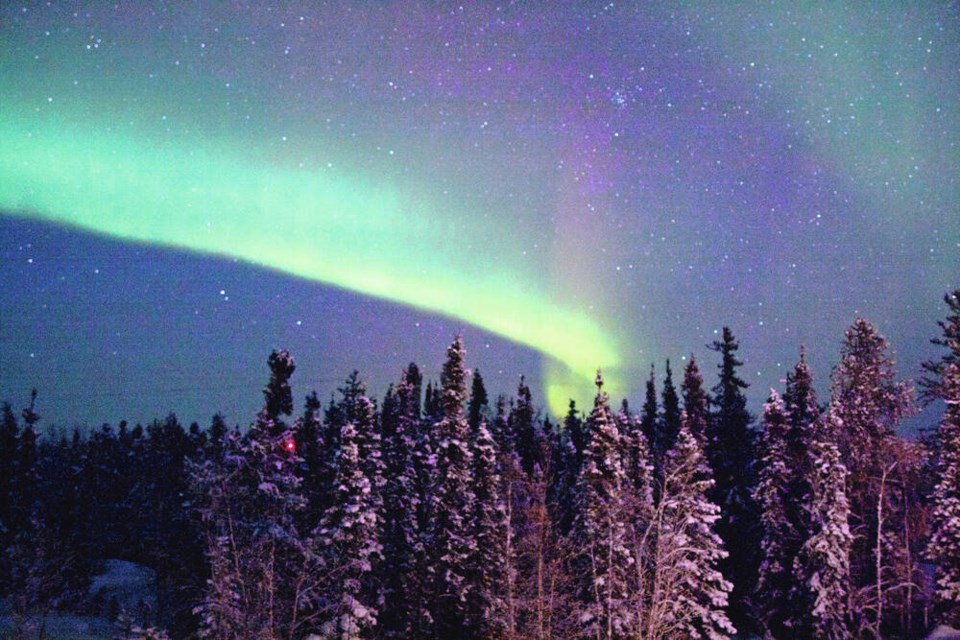A rare display of aurora borealis lit up the night sky over the south coast a couple of weeks ago. On Oct. 12, beginning around 9:30 p.m., even those living in the Lower Mainland and on the Island had the chance to enjoy the light show.
The shimmering curtains of light usually keep to more northerly latitudes. Folks in Fort St. John, Prince George, Vanderhoof and, of course, Atlin see the northern lights more often than we do. Even Kamloops is more likely to see them.
That Thanksgiving’s event reached our latitude is thanks to a solar storm sweeping down on Earth’s magnetic field.
On Oct. 9, specialists with NASA’s Solar Dynamics Observatory reported a solar flare erupting from a sunspot on the Sun’s surface. Accompanying the flare was a level 2 coronal mass ejection. The two phenomena created a one-two punch of high-velocity charged particles blasted directly towards Earth.
When the storm arrived on Oct. 11 and 12, the billions of tonnes of solar particles collided with gases in the Earth’s ionosphere, an electrically charged layer of our upper atmosphere, releasing energy visible as light.
The sun is a nuclear fusion-powered dynamo. It is made of plasma, a gas-like state of matter where electrons and ions have separated, creating a super-hot mix of charged particles. The high temperatures cause the ions and electrons to flow constantly.
When charged particles move, they create magnetic fields. These fields, in turn, affect how the particles move.
The Sun’s plasma flows generate many complicated magnetic fields that twist and turn beneath, within, on and above the Sun’s surface. Sometimes the fields tangle. This happens when sunspots — the darker, cooler regions of the sun’s surface — form. When the tangled fields erupt, solar flares blast out.
Solar flares are the solar system’s largest explosive events.
Coronal mass ejections happen when the Sun’s outer atmosphere — the corona — becomes confined within closed, looping magnetic fields within the corona. This often happens above groups of sunspots. The confined solar atmosphere can suddenly belch bubbles of gas and magnetic fields.
That sounds innocuous. But we’re talking about the Sun, the star that drives our solar system, accounts for more than 99.8 per cent of the solar system’s mass, and — were it hollow and not an incandescent sphere of swirling, 15 million C, highly pressurized plasma — would easily fit more than 1.3 million Earths inside. There’s nothing innocuous about it.
Coronal mass ejections — or ejections of mass (i.e., “stuff”) from the Sun’s corona — can contain billions of tonnes of matter, hurled out from the Sun’s atmosphere in a spectacular explosion at speeds of about five million km/h.
All that highly charged solar material streams into space, smacking into everything in its path.
When coronal mass ejections sweep across Earth’s own upper atmosphere, they can ramp up the northern lights and make them visible over much wider areas.
It’s not just the amount of matter colliding in our upper atmosphere that amplifies the display. The intensity of the solar storm deforms our own magnetosphere, compressing it more than usual on the sunward side and causing it to stream out more flatly away from the sun.
This pushes, stretches and broadens the auroral band further towards our balmy latitude on the Earth’s nighttime side. (You can watch this on the NOAA’s Space Weather Prediction Centre, at https://www.swpc.noaa.gov.)
The different colours of the northern lights depend on which molecules are pinged in the ionosphere. When solar particles hit oxygen molecules, red, yellow or green light results — with an emphasis on green. When the particles smack into nitrogen, the reaction emits blue and purplish-red hues.
The Sun goes through 11-year cycles of activity and rest. Beginning last year, it entered Solar cycle 25, which means aurora are likely to become increasingly common over the next few years, before peaking in about 2025.
Whether or not many of those future light shows will be visible from the south Island remains to be seen.
• Don’t want to miss the next aurora event over Vancouver Island? Check out these resources:
Sign up for aurora alerts from the University of Alberta’s AuroraWatch, at aurorawatch.ca/content/view/26/60/.
Check out the 24-hour aurora forecast for Canada at spaceweather.gc.ca/forecast-prevision/short-court/zone-en.php or NOAA’s Space Weather Prediction Centre, at swpc.noaa.gov.
Monitor #AuroraBorealis, #NorthernLights and #Vancouver or #Victoria on Twitter.



